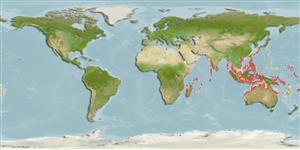>
Eupercaria/misc (Various families in series Eupercaria) >
Labridae (Wrasses) > Corinae
Etymology: Macropharyngodon: Greek, makros = great + Greek, pharyngx = pharynx + Greek,odous = teeth (Ref. 45335).
More on author: Randall.
Environment: milieu / Zona climática / intervalo de profundidade / distribution range
Ecologia
marinhas associadas(os) a recifes; não migratória; intervalo de profundidade 2 - 30 m (Ref. 90102). Tropical
Indo-Pacific: Sri Lanka, western Australia, Indonesia and New Guinea.
Tamanho / Peso / Idade
Maturidade: Lm ? range ? - ? cm
Max length : 13.0 cm TL macho/indeterminado; (Ref. 30874)
Raios dorsais (total) : 11; Raios anais : 11. Brown to greenish with pearly to metallic-green spots along scale rows (Ref. 48636). Females reddish anteriorly, shading to blackish posteriorly, with greenish yellow spots edged in blue and black (1 per scale) on body and similar spots and irregular bands on head. Males similar in colour to females, with no black humeral spot (Ref 9823).
Body shape (shape guide): fusiform / normal.
Inhabits lagoon and sheltered seaward reefs, in areas with mixed sand, rubble, and coral to at least 30 m. Occurs singly or in small groups (Ref. 9710).
Ciclo de vida ou comportamento de acasalamento
Maturidade | Reprodução | Desova | Ovos | Fecundidade | Larvas
Oviparous, distinct pairing during breeding (Ref. 205).
Randall, J.E., 1978. A revision of the Indo-Pacific labrid fish genus Macropharyngodon, with descriptions of five new species. Bull. Mar. Sci. 28(4):742-770. (Ref. 2694)
Status na Lista Vermelha da UICN (Ref. 130435: Version 2025-1)
Ameaça para os humanos
Harmless
Uso pelos humanos
Pescarias: espécies comerciais; Aquário: Espécies comerciais
Ferramentas
Relatórios especiais
Baixar XML
Fontes da internet
Estimates based on models
Preferred temperature (Ref.
123201): 25.2 - 29.2, mean 28.6 °C (based on 2494 cells).
Índice de diversidade filogenética (Ref.
82804): PD
50 = 0.5002 [Uniqueness, from 0.5 = low to 2.0 = high].
Bayesian length-weight: a=0.00977 (0.00466 - 0.02049), b=3.07 (2.90 - 3.24), in cm total length, based on LWR estimates for this (Sub)family-body shape (Ref.
93245).
Nível Trófico (Ref.
69278): 3.5 ±0.4 se; based on size and trophs of closest relatives
Resiliência (Ref.
120179): Elevada, tempo mínimo de duplicação da população menor que 15 meses (Preliminary K or Fecundity.).
Fishing Vulnerability (Ref.
59153): Low vulnerability (10 of 100).
🛈
Nutrients (Ref.
124155): Calcium = 94.4 [56.1, 164.7] mg/100g; Iron = 0.75 [0.43, 1.40] mg/100g; Protein = 18.5 [15.7, 20.7] %; Omega3 = 0.166 [0.104, 0.268] g/100g; Selenium = 22.6 [13.0, 42.0] μg/100g; VitaminA = 155 [48, 598] μg/100g; Zinc = 1.71 [1.15, 2.66] mg/100g (wet weight);
